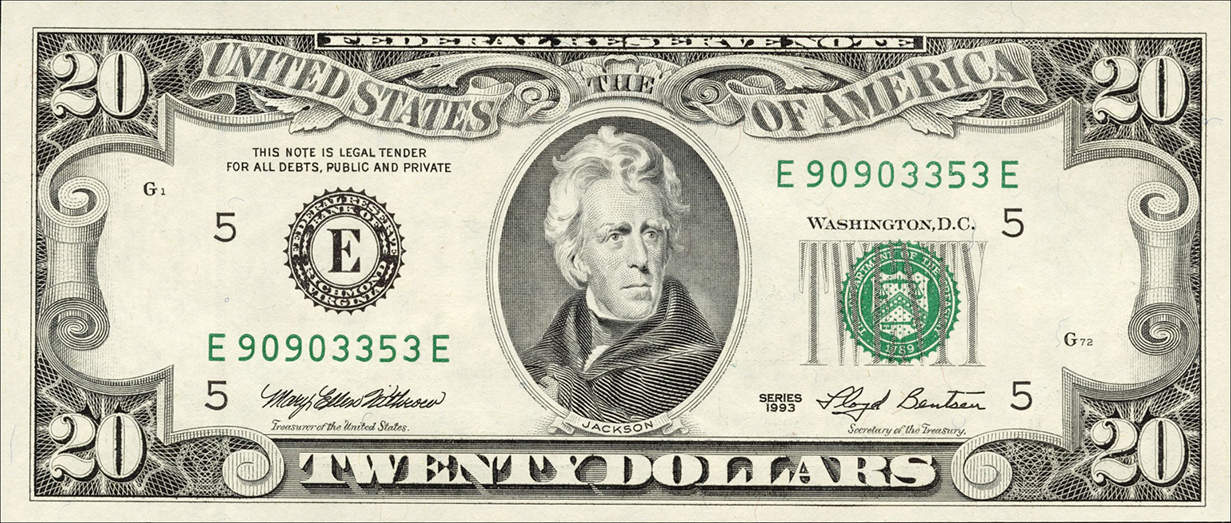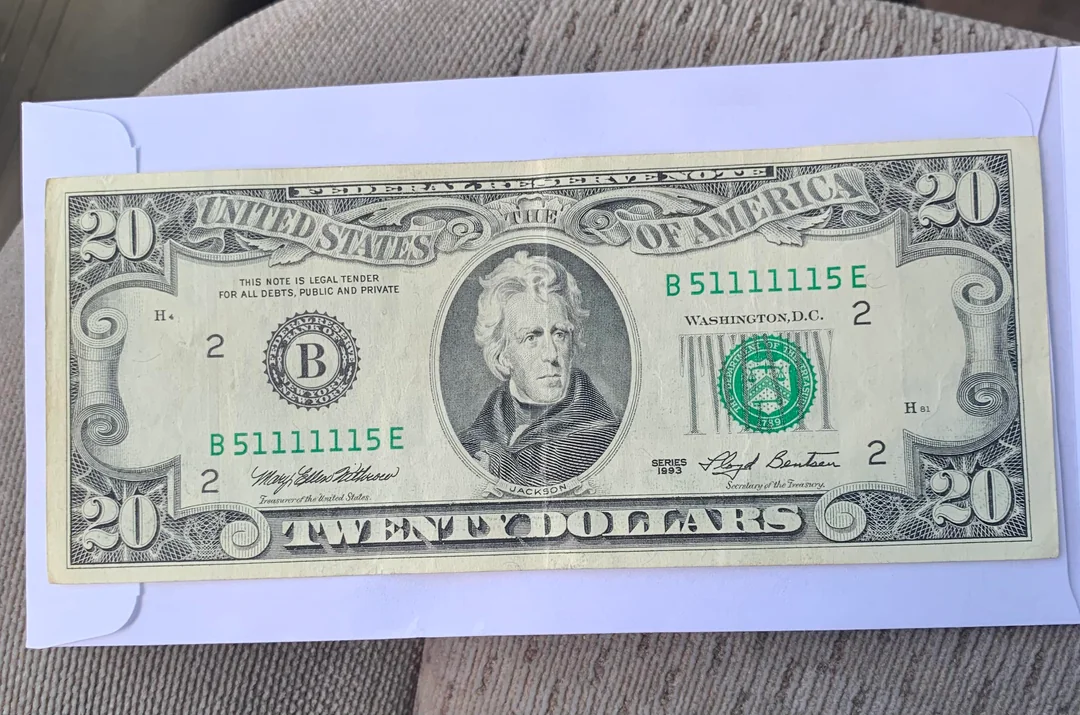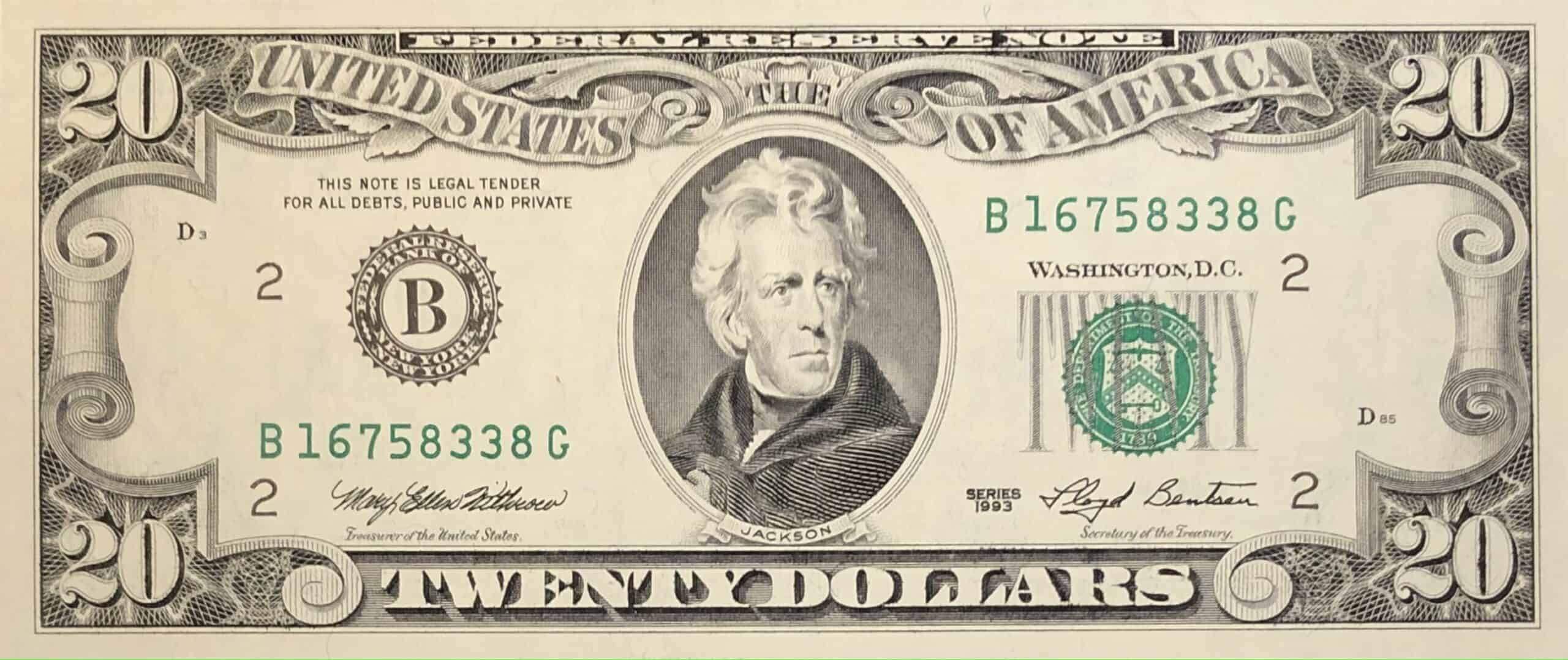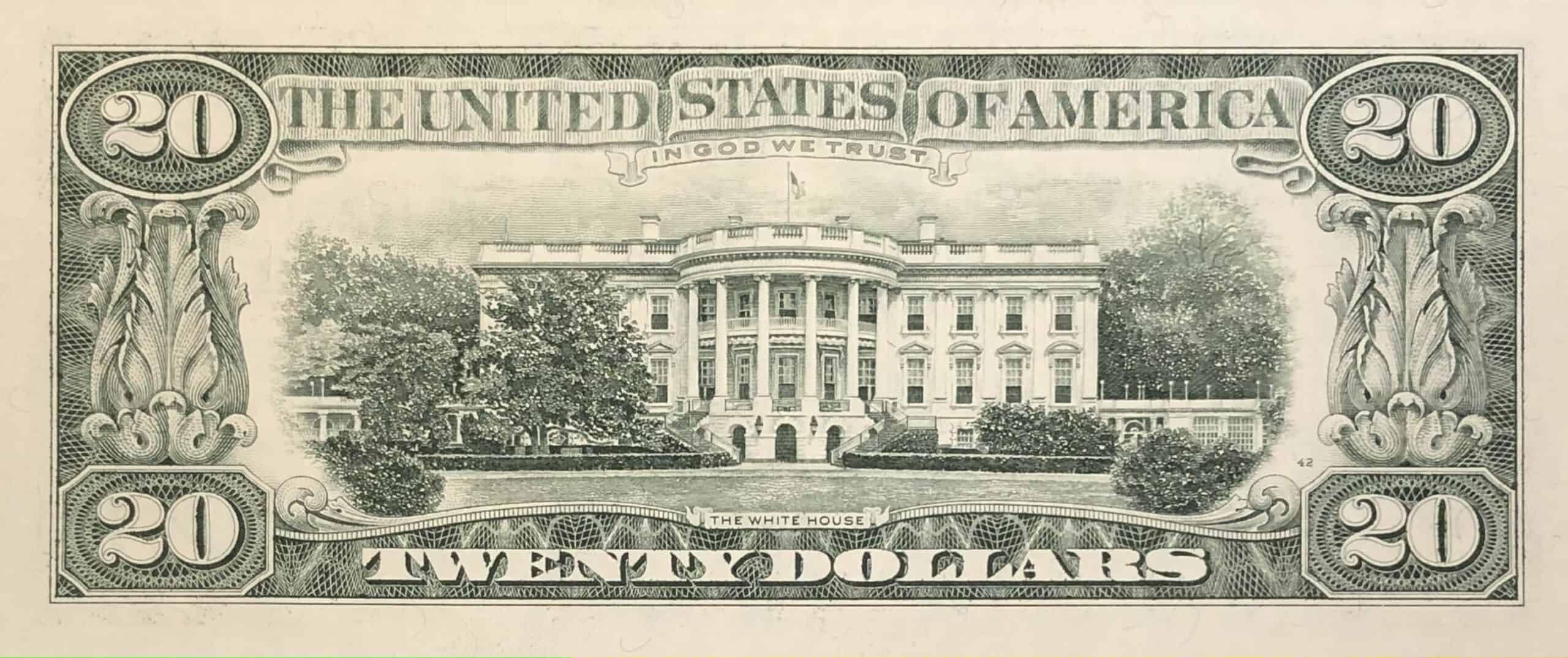1993 $20 Dollar Bill Value: How Much Is It Worth Today?

With $20 Bills printed after 2003, high-tech security features were built in for counterfeiters. They included some accessibility tweaks too, to help visually-impaired citizens. But on older notes, it’s a little tougher to spot fakes. And those earlier notes have more investment merits as well. Let’s look at the 1993 20 Dollar Bill Value, its history, and its market presence today.
1993 20 Dollar Bill Value Chart |
||||
| $20 Bill Series | District/Branch | Date of Sale | Grade | Price |
| Fr. 2079-A 1993 $20
Solid #6s Serial Number |
Boston | 17th July 2023 | 66 EPQ Gem Uncirculated | $2,220 |
| Fr. 2079-E 1993 $20
Low Serial Number |
Richmond | 19th March 2013 | Choice Uncirculated | $440.63 |
| Fr. 2079-F 1993 $20 Solid #5s Serial Number | Atlanta | 25th August 2023 | 66 EPQ Gem Uncirculated | $2,400 |
| Fr. 2080-L 1993 $20 Radar Serial Number | San Francisco | 3rd February 2022 | 66 EPQ Gem | $144 |
| Fr. 2080-L* 1993 $20 | San Francisco | 23rd March 2022 | 67 EPQ Superb Gem Uncirculated | $80 |
History of the 1993 20 Dollar Bill

The $20 Bill was introduced in 1861. Originally, they were large-sized bills. But in 1928, they shrunk with the rest of our paper money and their design changed to Andrew Jackson, the 7th US President. Like George Washington and Benjamin Franklin before him, Andrew Jackson didn’t want to be on American money. But public opinion prevailed 83 years after his death.
Washington and Franklin disagreed with their faces on coins because the colonial monarchs started it, and they felt a democratic America should avoid royal relics. But in Jackson’s case, his issue was with paper money and the idea of a National Bank. He was all about precious metal coins and dismantled the Second Bank of the United States for corruption and elitism.
Coincidentally, 1928 marked 100 years since Jackson ascended to the presidency, but the US Treasury insisted this had nothing to do with his selection for the $20 Bill. They said they picked him because he was a familiar face in terms of presidential popularity. But he’s still a controversial figure for owning hundreds of slaves and signing the 1830 Indian Removal Act.
The Colours of the $20 Bill
The White House went behind the $20 note, and we still use these features on today’s $20 Bills. That said, both devices were revamped for the 2003 Series of $20 Bills. For reference, the device is the image, portrait, or picture on any note. The background behind the device is called the field. Like other American notes, the front of the $20 Bill is printed with black ink.
The back uses green ink, which is why US Dollars are sometimes called greenbacks. Two of the earliest versions of the $20 Bill served as Gold Certificates and Silver Certificates. You could exchange them for $20 worth of gold or silver coins or ingots (and vice versa). People might do this if they were traveling and didn’t want to carry large amounts of precious metal.
Gold Certificates often had a yellow seal and an orange back while Silver Certificates might have a blue seal and a black back. But legal tender couldn’t be swapped for metal equivalents. With American bank notes, the year written on the note has a special meaning. It’s the year when the design was first approved. Notes can use the same series date for several years.
Features of the 1993 20 Dollar Bill
We’ve mentioned the devices and fields, so here are a few more technical terms that describe currency. The heads side is the obverse, the tails side is the reverse, and the words are mottos or legends. The reverse is printed first, by rolling an impression cylinder over a back plate. Then comes the obverse face plate, and finally a colored pass with seals and serial numbers.
The Obverse of the 1993 20 Dollar Bill

It shows Andrew Jackson with his name below his portrait. The District Seal is on his left and the Treasury Seal is on his right. The top of the $20 Bill says Federal Reserve Note followed by The United States of America. The bottom says Twenty Dollars. The Treasurer’s signature is above Twenty and the Secretary’s signature plus the series year is above Dollars.
Tiny letter-number combinations show the face plate position on the inner top left and the inner bottom right. Flanking the device, the word Twenty is on the right, below Washington DC, and overlaid with the Treasury Seal. The colored serial numbers appear twice and the district number is printed four times. The legal tender statement is above the District Seal.
The Reverse of the 1993 20 Dollar Bill

It shows the White House. The top of the note says The United States of America followed by the motto In God We Trust. The bottom of the note says The White House, with the phrase Twenty Dollars below it. The sides have decorative elements and the four outer corners have the denomination 20 in numerals. The inner bottom right corner has the back plate number.
Other Features of the 1993 20 Dollar Bill
The 1993 $20 is a small size note, so it’s 156mm wide, 66.3mm high, and weighs about a gram. The note is 25% cotton and 75% linen. It has a plastic strip embedded near its left margin. On average, a $20 Bill circulates for 7 years and 9 months before it’s too tattered and has to be replaced. When you get $20 Bills from the bank, they’re bundled with violet straps.
1993 20 Dollar Bill Value Guides
$20 Bills can be identified by their district. These are the 12 Federal Reserve Bank branches. They’re identified using A to H and 1 to 12. The district number is in the seal and it’s the first or second letter on serial numbers. But all these bank notes are printed in Washington DC or Fort Worth. The latter have FW in the bottom right obverse before the face plate number.
Paper money also has an Fr. Number as listed in the book Paper Money of the United States. Fr. is for Robert Friedberg, the author. It shows the features of the note at a glance. A lot of the $20 Bills from 1993 are Fr. 2079s and Fr. 2080s with corresponding district letters. Star notes are replacements for damaged notes. They have the ruined serial number with a star.
1993 $2 Bill Value
The 1993 Series of $20 Bills was signed by Treasury Secretary Lloyd Millard Bentsen Jr. and Treasurer Mary Ellen Hinamon Withrow. Their price differences are largely driven by rarity and condition. Fancy serial numbers can play a role too. On 25th August 2023, an Atlanta Fr. 2079-F 1993 $20 sold for $2,400 because of Solid #5 Serial Numbers. A Boston was cheaper.
One month earlier on 27th July 2023, a Boston Fr. 2079-A 1993 $20 was $2,220 with Solid #6 Serial Numbers. Both notes were graded 66 EPQ Gem Uncirculated. Also, star notes are said to be extremely expensive, but that’s not always the case. An Fr. 2080-L with radar serial numbers sold for $144 in February 2022 and an Fr. 2080-L* was $80 a month later.
1993 20 Dollar Bill Grading
PCGS (Professional Coin Grading Service) has a department that deals with paper money. But it’s best known for grading coins. And its main competitor, NGC (Numismatic Guaranty Company/Corporation) started a sister company called PMG (Paper Money Guaranty) that works exclusively with bank notes. They grade cash using the Sheldon Scale from 1 to 70.
1993 20 Dollar Bill Errors
US bank notes are printed in three swipes. The printing paper is placed on a board to hold it in place. An inked impression cylinder first rolls over the back plate to transfer the reverse designs. It then rolls over the face plate to imprint the obverse details. The third pass prints the seals and serial numbers. Mistakes or inadvertent movements can happen at any stage.
These mint mistakes can raise the resale value of both coins and paper money, so it’s useful to recognize the most important ones. These include inking errors, misalignments, missing details e.g. the seal, cutting mistakes, folded printing paper, wrong serial numbers, etc. Some are worth hundreds or even thousands of dollars, so let’s look at 1993 20 Dollar Bill Errors.
Fr. 2079-E 1993 $20 Misalignment Error
If the board or printing paper shifts, the design details can end up in the wrong spot. This is called a misalignment error. Here, the paper moved sideways about 30% so the side margin ended up in the middle. But the third strike was normal so the serial numbers and seals are properly placed. In Gem Uncirculated 66 EPQ, it was $3,120 in 2023 but $4,320 in 2021.
Fr. 2079-C 1993 $20 Misalignment Error
Misalignments aren’t always drastic so you have to look for them carefully. The less dramatic ones don’t cost as much, but they can still be worth something. On this Philadelphia note, it’s the third strike that shifted. The District Seal, Treasury Seal, and serial numbers are all lower than they should be and they’ve veered to the left. A Choice AU 58 was $660 in March 2023.
Fr. 2080-J 1993 $20 Mismatched Serial Number
The letters on serial numbers have different meanings. On early notes, the first letter is the district. On newer ones with two letters, the first letter shows the series year. The second is the district number. But here, you have to double-check the digits themselves. The top right ends with 526 and the bottom left with 536. In Choice EF 45, it was $432 in August 2022.
Fr. 2080-K 1993 $20 Fold Over Error
American paper money is printed on sheets that hold multiple notes. That’s why face plate numbers include an alphabetical letter to show the position of a specific note on the uncut sheet. But sometimes, the sheet folds over before it gets sliced into individual notes. That’s what happened here. Graded 65 EPQ Gem Uncirculated, it was $1,020 in December 2021.
Fr. 2080-L 1993 $20 Fold Over Error
A printed fold error is similar to a fold-over error. But in this case, the fold happened on the uncut sheet so some design details got stamped on the wrong side or in the wrong position. On this note, part of the District Seal and lower left serial number got printed on the reverse fold during the third strike. In AU 55, this San Francisco $20 was $432 in December 2021.
Fr. 2079-E 1993 $20 Pre-Overprint Foldover
The third strike – the one with seals and serial numbers – is sometimes called the overprint because the Treasury Seal is stamped on top of the word Twenty. And on this error note, the paper folded after the second strike so the Treasury Seal and upper right serial number were on the reverse fold. It was cut that way. In Choice AU 58, it sold for $1,920 in August 2019.
Fr. 2079-C 1993 $20 Foldover Plus Ink Smear
If a note has multiple mint mistakes, its cumulative value rises. In this case, the $20 had a foldover that moved the Treasury Seal and part of the upper right serial number onto the back fold. The foldover left stencil traces too. But the impression cylinder was over-inked, leaving smears on the obverse as well. In Choice 64 EPQ, it was $552 in November 2018.
Fr. 2079-A 1993 $20 Missing Face Error
Earlier, we talked about the three printing strikes applied to any note. On this Boston $20 Bill, something went wrong during the second pass so the front of the note skipped its main design details. But the overprint worked fine, leaving the note with a blank obverse apart from the seals and serial numbers. Graded Gem 65 EPQ, it sold for $660 in March 2018.
Fr. 2080-G 1993 $20 Inverted Overprint
When bank notes are going through their three print passes, the paper is carefully flipped to ensure both sides are upright when you turn the note sideways. But here, the third strike or overprint was facing the wrong way. As a result, the serial numbers and seals appear upside down and on opposite sides. Graded 65 EPQ Gem Uncirculated, it sold for $446.50 in 2017.
Fr. 2080-G 1993 $20 Board Break
Sometimes, the most dramatic-looking error isn’t the most expensive. Here, a section of the backing board broke off so the printing paper wasn’t firmly secured beneath the impression cylinder. This kept the note blank on the broken upper segment of the back. It almost seems bleached. Graded as a Gem 66 EPQ, this Chicago $20 only sold for $164 on 15th March 2017.
Fr. 2079-B 1993 $20 Butterfly Fold
We’ve looked at several foldover errors and noticed that the district (and the timing of the sale) can affect pricing. This might be why a 2079-D graded EF 40 sold for $282. But let’s talk about the butterfly fold. It’s a specially deformed cut that flaps over like a butterfly wing and seems normal when it’s fully folded. In Choice AU, it sold for $235 in November 2015.
Fr. 2080-L 1993 $20 Insufficient Inking Error
Inking errors can occur at the mint, but they sometimes pop up at the bank. Underinking can sell for $100 or so, and it appears as a smudge on the back of the note that seeps to the front. But Insufficient Ink is a separate error type where sections of the note are blank due to the partial dipping of the impression cylinder. In 66 EPQ Gem Uncirculated, it sold for $270.25.
Fr. 2079-A 1993 $20 Face-to-Back Offset Error
If you’re familiar with coin errors, a face-to-back offset is like a die cap. After the first reverse strike, the paper got stuck on the impression cylinder. So when it did a front pass, a faded version of the obverse design got onto the reverse of the next note. It gives the note a blurry confusing appearance but it’s not an expensive error. An AU sold for $103.50 in March 2010.
1993 $20 Third Printing on Back
If the error on a $20 is mechanical, it might not get a Friedberg Number. In this case, the $20 Bill was accidentally flipped after the second pass. Usually, the note stays with its front facing up so the impression cylinder can overprint. But here, the note turned before the third pass so the seals and serial numbers were on the back. Graded AU, it was $218.50 in 2010.
1993 20 Dollar Bill FAQ
How Can You Tell if a 1993 $20 Bill is Real?
On newer notes printed after 2003, lots of anti-counterfeiting features are built-in. But even on a 1993 $20 Bill, you can place the note beneath a light source and check for an internal plastic thread on the left side of the note. This was introduced from the 1990 series onward.
